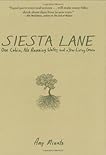 Siesta Lane: One Cabin, No Running Water, and a Year Living Green by Amy Minato
Siesta Lane: One Cabin, No Running Water, and a Year Living Green by Amy MinatoMy rating: 4 of 5 stars
I spotted this book displayed prominently at the library. I typically place library books on hold and have my hubby pick them up for me...so actually visiting the library is always a rare treat. I often end up discovering books I would not have found otherwise. Inevitably, I take a stack of books to a computer and log onto Goodreads to determine whether they are worth my time.
Siesta Lane was one of my good finds from last weekend.
I loved this little gem of a book. Someone on Goodreads described it as Walden if it had been written by a woman. It also reminds me a bit of Anne Morrow Lindberg's Gift from the Sea.
Stuck in a Chicago traffic jam, Amy Minato decided she needed to shake up her life and get back to the bare roots.
She moved to Oregon and pursued a graduate degree in environmental studies, but felt that Eugene was still too much of a big city for her. So she fled the city to a remote wooded area where she rented a 10x12 cabin as part of an intentional cohousing community.
Each cabin had electricity, but no kitchen facilities or running water. All of the occupants of the eight cabins used the main house for their cooking and bathing needs. Heat was provided by wood stoves. They grew a lot of their food, and the occupants lived a simple, back-to-the earth lifestyle as much as possible. It was true community living in all its glory and challenges.
As I've mentioned before, I am fascinated by "one year experiment" memoirs. Minato actually did not want to leave Siesta Lane after a year, but she was forced to because of a change in ownership of the land.
Beyond the actual content of this book, I loved the language. Minato's poetic background clearly shines through. She intersperses chapters describing her life in the woods with photos, poems, and drawings.
And here are some passages that illustrate her gift for language and the contemplative life:
"Impulsive people are, it seems, more likely to be outcasts--crazy artists. Western culture values, requires order, efficiency, organization. But it is nonlinear shadows lurking around the edges of society--folk who keep the spirit alive, honor mystery and the irrefutable bent of everything in the unniverse toward chaos."
"I go on one date with a law student and feel my soul slump under the chair."
"The communal spirit is a spider running on slender legs across the threads of the web, strengthening here, slacking there, making sure the relationships can carry her shimmering, necessary weight."
"We pick a few splotchy apples from a wild tree, ones it seemed unlikely other creatures would harvest. They are pinched and tart, keeping their juices to themselves, their sweetness in reserve. As people do, who are unloved for too long."
"It's the Pacific Northwest, after all, and rain's the lover who won't stop tickling you."
My favorite part of the book came toward the beginning, when Minato's brother comes to visit, presumably to spy on her for her conservative mom. Minato created a "daily schedule," which she posted on the community bulletin board for her brother's pleasure. The schedule contained such activities as "sun chant/ritual cleansing with guru, colonics, vegan dinner, sunset drumming circle, group howl, and an admonition to wear clothing because her brother would be visiting." Just the kind of teasing I love!
She also ponders the crazy number of choices we demand in our western culture ("why must there be 30 kinds of cereal?...I had always believed that the more choices in life, the better, but now it doesn't seem true.") and she mentions her Norwegian friend who gets irate at the number of choices offered to him in American restaurants--such a broad array of choices is wholly American! I will never forget Mike's first trip to visit me in Oregon, and his bewilderment at the sheer number of choices offered to him when he ordered a sandwich.
After finishing the book this evening, I googled Amy Minato to find out more about what she is doing now. And wonder of wonders, she lives right in my neck of the woods, in Multnomah Village. According to an Oregonian article, she likes living here because of the feeling of community within a city. And she teaches writing regularly in the village. What a delightful discovery!
View all my reviews
No comments:
Post a Comment